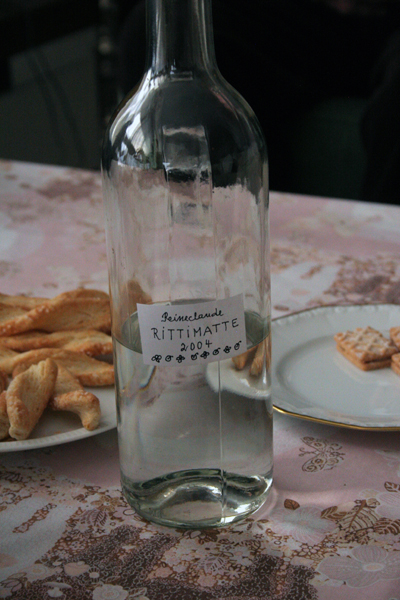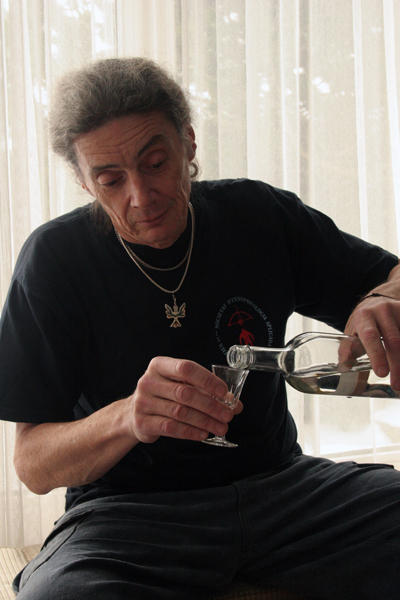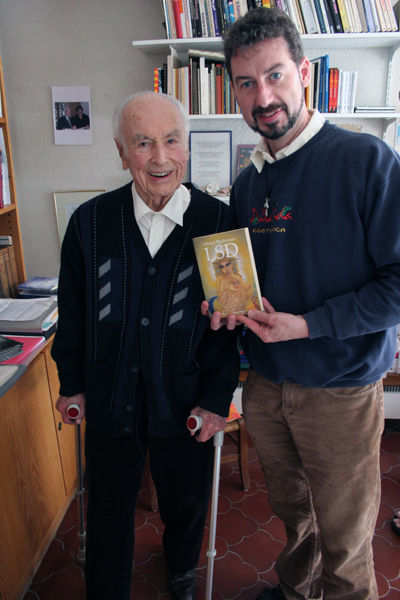The 2008 World Psychedelic Forum
Basel, Switzerland
v1.0 - June 2008
Originally published in Erowid Extracts
Citation: Hanna J. "The 2008 World Psychedelic Forum". Erowid Extracts. Jun 2008;14:19.
Switzerland in spring is more hospitable than Switzerland in winter: cold, but not bone-chilling cold. It is impossible to avoid comparing and contrasting the January 2006 "LSD: Problem Child and Wonder Drug" conference celebrating Albert Hofmann's 100th birthday with the March 2008 "World Psychedelic Forum: Consciousness Change, A Challenge of the 21st Century". Both were produced by the Gaia Media Foundation at the Congress Center in Basel, and each included approximately 70 speakers. To the conference producers' credit, only about a third of the presenters were common to both gatherings, and this one featured a bounty of generally new faces in the scene, due to the inclusion of six "Rising Researchers" panels moderated by Thomas B. Roberts. These panels were extremely well attended and represented the considerable breadth and depth of current psychedelic research. While unquestionably still a minority, there were twice as many women presenters at this year's event, suggesting that the event producers actively responded to feedback related to the scarcity of females at the previous conference. Overall there didn't seem to be as many attendees this year as there were two years ago and it was also clear that many more of the people present hailed from Europe, whereas in 2006 there was a more sizable American contingent. Art and collected ephemera were less prevalent in the exhibition hall, and the bookstore seemed a bit smaller in 2008, but the overall vibe of enthusiasm and high-quality data exchange was retained.
I was involved with several presentations at the event. On short notice, Forum producer Dieter Hagenbach asked if I would deliver a paper written by drug war prisoner William Leonard Pickard titled "International LSD Prevalence: Factors Affecting Proliferation and Control". The paper was presented in memory of John Beresford, who passed away on September 2, 2007, a longtime advocate for releasing drug war prisoners and a mutual friend of Leonard and mine. One interesting topic from Pickard's paper was his discussion of the Narcotic and Dangerous Drug Information System (NADDIS), which compiles records, creates reports on "individuals of interest", and makes these available online to investigators in law enforcement. Pickard points out that, despite being "the most widely used tool is drug law enforcement", integrating everything from freeway toll records to witness interviews, it is virtually unknown to the general public. Pickard quotes from the 7th Circuit Court of Appeals in the U.S., a court that holds review power over drug cases from Indiana to Wisconsin: "It would be nice to know something about NADDIS." A full copy of the paper will eventually be posted on FreeLeonardPickard.org. I handed out a hundred flyers with the names and addresses of over a dozen drug war prisoners, encouraging listeners to pick at least one prisoner and initiate correspondence. There are several drug war prisoners with whom I have been corresponding for over a decade, so I was happy to deliver this talk and encourage others to find a prisoner pen-pal.
During the conference closing ceremonies I was given the opportunity to say a few words about the underground chemists who risk their freedom to provide people their experiences with psychedelics. I also played a short phone message recorded earlier that day from such a chemist, Casey Hardison, who is serving a twenty-year prison sentence in England. Although the sound quality was not great, it was nevertheless a poignant moment (his message is now posted at freecasey.org), and several people thanked me afterwards for drawing attention to the plight of drug war prisoners.
In 2006 I presented a collection of hallucinatory animation that I had edited together, featuring clips from the 1920s through to the early 2000s. This was shown to about 600 people at that event; so in 2008, I created a second similar compilation DVD, with all-new material from the 1930s until the present. In an effort to include more films in 2008, the event organizers assigned a tiny room for projections, and unfortunately the film schedule did not appear in the main program. With five concurrent sessions happening most of the time--six, if you count films--there was much more than anyone could possibly take in. This resulted in small audiences for all of the films, and attendance for my screening was sparse. Nevertheless, those who did show up were enthusiastic, and I gave away at least a dozen discs to viewers who requested them.
I later co-presented with Sylvia Thyssen about our work with Erowid. We kicked off with a video of Sasha and Ann Shulgin, who were unable to attend the event due to Sasha's pending heart surgery. (He is back at home now, recovering well.) After the video, Sylvia and I discussed the process by which assumptions or errors of fact related to psychoactives may be accepted as truth. Several specific examples were presented, including the theory that oracular predictions in ancient Delphi resulted from ethylene inhalation, the theory of pineal DMT production, and the common problem of researchers citing and misrepresenting content from papers that they have not actually read. We described general biases that need to be acknowledged, and pointed toward techniques that incorporate the sort of diligent awareness required to thwart such mistakes.
I also spent time helping Sylvia staff the Erowid booth at the conference, along with Erowid volunteers John Paul and Katherine. Many conference attendees stopped by the booth to wish us well with our work on the site or to become members and make a donation. We also had numerous opportunities to field "Ask Erowid" type questions regarding visionary plants and drugs from those in attendance.
One of the more interesting queries came from a couple of individuals who had met because they were suffering from symptoms of Hallucinogen Persisting Perception Disorder (HPPD), purportedly as a result of their use of butanamines such as 1-(4-bromo-2,5-dimethoxypheneyl)-2-butamine. They were wondering if we had heard of such effects. (When I later discussed this with Sasha Shulgin at his house in early April he opined, "That sounds like some sort of brain damage.") Unfortunately, when exotic research chemicals such as 4C-DOB are involved--and particularly if psychonauts are reluctant to report on the effects of their experiments due to their fear of drawing unwanted attention to unscheduled compounds--it is difficult or impossible to gauge the prevalence of specific side effects.
For some attendees, particularly those who didn't make it in 2006, the greatest disappointment was that Dr. Hofmann wasn't in attendance. The reason for his absence was uncertain--possibly a failing memory, perhaps consternation that the event was held over Easter weekend, or maybe just an increasing reluctance to travel.
After the conference, on March 25, I was fortunate enough to visit him at his home in Rittimatte, with Jonathan Ott and Andrew Sewell. The picturesque drive up to his property--a portion of which extends into France--was straight out of Swiss calendar art with snow-capped chalets dotting the mountainside. Albert was spry and sharp as a tack, speaking to us fluently in both German and English. There was no indication during our visit that he only had a month to live. His home contained an indoor swimming pool and multiple staircases, so he clearly had ample opportunity for exercise, even inside during the winter months. Pointing out an inversion table, Jonathan Ott mentioned that Albert had constructed his own gravity boots in order to obtain the health benefits of hanging upside-down. Albert just smiled. We took in the breathtaking view from his office, and he showed us the shelf where he keeps the many translations of his book LSD -- mein Sorgenkind. He was particularly tickled by the cover art on the Czech translation depicting a bare-breasted woman with a 1970s hairdo. We then went upstairs to his library, where he showed us some of his visionary art collection.
Later, back downstairs, a ceramic cat that Albert had sculpted was accompanied by an occasional mew from his pet cat. He proudly offered us schnapps that he had distilled in 2004 from plums he had picked off of trees on his property that grew from pits he had planted some thirty-seven years earlier when he bought the place. Now that's going the whole nine yards to make some booze! Jonathan declared it to be "Hofmann's other elixir"; the taste was clean, clear, and potent. Albert joyfully recounted stories of past exploits as we sat enthralled. Eventually we said our goodbyes, and drove back down the mountain. I feel honored to have been able to spend some time with Dr. Hofmann at his home.
The Basel conference was once again a rousing success, bringing together the tribe, rekindling old friendships and sparking new ones. The number of current studies discussed in the "Rising Researchers" panels alone clearly shows that there is a renaissance of interest in psychedelic investigations. Many of these researchers were quite a bit younger than other presenters, suggesting a hopeful future for this area of study. I look forward to the next event that Gaia Media Foundation produces.
From Behind Bars
I was involved with several presentations at the event. On short notice, Forum producer Dieter Hagenbach asked if I would deliver a paper written by drug war prisoner William Leonard Pickard titled "International LSD Prevalence: Factors Affecting Proliferation and Control". The paper was presented in memory of John Beresford, who passed away on September 2, 2007, a longtime advocate for releasing drug war prisoners and a mutual friend of Leonard and mine. One interesting topic from Pickard's paper was his discussion of the Narcotic and Dangerous Drug Information System (NADDIS), which compiles records, creates reports on "individuals of interest", and makes these available online to investigators in law enforcement. Pickard points out that, despite being "the most widely used tool is drug law enforcement", integrating everything from freeway toll records to witness interviews, it is virtually unknown to the general public. Pickard quotes from the 7th Circuit Court of Appeals in the U.S., a court that holds review power over drug cases from Indiana to Wisconsin: "It would be nice to know something about NADDIS." A full copy of the paper will eventually be posted on FreeLeonardPickard.org. I handed out a hundred flyers with the names and addresses of over a dozen drug war prisoners, encouraging listeners to pick at least one prisoner and initiate correspondence. There are several drug war prisoners with whom I have been corresponding for over a decade, so I was happy to deliver this talk and encourage others to find a prisoner pen-pal.
"The 2008 event featured a bounty of generally new faces in the scene, due to the inclusion of six "Rising Researchers" panels."
Psychopticon Animatris II
In 2006 I presented a collection of hallucinatory animation that I had edited together, featuring clips from the 1920s through to the early 2000s. This was shown to about 600 people at that event; so in 2008, I created a second similar compilation DVD, with all-new material from the 1930s until the present. In an effort to include more films in 2008, the event organizers assigned a tiny room for projections, and unfortunately the film schedule did not appear in the main program. With five concurrent sessions happening most of the time--six, if you count films--there was much more than anyone could possibly take in. This resulted in small audiences for all of the films, and attendance for my screening was sparse. Nevertheless, those who did show up were enthusiastic, and I gave away at least a dozen discs to viewers who requested them.
Erowid In Basel
I later co-presented with Sylvia Thyssen about our work with Erowid. We kicked off with a video of Sasha and Ann Shulgin, who were unable to attend the event due to Sasha's pending heart surgery. (He is back at home now, recovering well.) After the video, Sylvia and I discussed the process by which assumptions or errors of fact related to psychoactives may be accepted as truth. Several specific examples were presented, including the theory that oracular predictions in ancient Delphi resulted from ethylene inhalation, the theory of pineal DMT production, and the common problem of researchers citing and misrepresenting content from papers that they have not actually read. We described general biases that need to be acknowledged, and pointed toward techniques that incorporate the sort of diligent awareness required to thwart such mistakes.
I also spent time helping Sylvia staff the Erowid booth at the conference, along with Erowid volunteers John Paul and Katherine. Many conference attendees stopped by the booth to wish us well with our work on the site or to become members and make a donation. We also had numerous opportunities to field "Ask Erowid" type questions regarding visionary plants and drugs from those in attendance.
One of the more interesting queries came from a couple of individuals who had met because they were suffering from symptoms of Hallucinogen Persisting Perception Disorder (HPPD), purportedly as a result of their use of butanamines such as 1-(4-bromo-2,5-dimethoxypheneyl)-2-butamine. They were wondering if we had heard of such effects. (When I later discussed this with Sasha Shulgin at his house in early April he opined, "That sounds like some sort of brain damage.") Unfortunately, when exotic research chemicals such as 4C-DOB are involved--and particularly if psychonauts are reluctant to report on the effects of their experiments due to their fear of drawing unwanted attention to unscheduled compounds--it is difficult or impossible to gauge the prevalence of specific side effects.

|

|

|
A Visit With Dr. Hofmann
For some attendees, particularly those who didn't make it in 2006, the greatest disappointment was that Dr. Hofmann wasn't in attendance. The reason for his absence was uncertain--possibly a failing memory, perhaps consternation that the event was held over Easter weekend, or maybe just an increasing reluctance to travel.
After the conference, on March 25, I was fortunate enough to visit him at his home in Rittimatte, with Jonathan Ott and Andrew Sewell. The picturesque drive up to his property--a portion of which extends into France--was straight out of Swiss calendar art with snow-capped chalets dotting the mountainside. Albert was spry and sharp as a tack, speaking to us fluently in both German and English. There was no indication during our visit that he only had a month to live. His home contained an indoor swimming pool and multiple staircases, so he clearly had ample opportunity for exercise, even inside during the winter months. Pointing out an inversion table, Jonathan Ott mentioned that Albert had constructed his own gravity boots in order to obtain the health benefits of hanging upside-down. Albert just smiled. We took in the breathtaking view from his office, and he showed us the shelf where he keeps the many translations of his book LSD -- mein Sorgenkind. He was particularly tickled by the cover art on the Czech translation depicting a bare-breasted woman with a 1970s hairdo. We then went upstairs to his library, where he showed us some of his visionary art collection.
Later, back downstairs, a ceramic cat that Albert had sculpted was accompanied by an occasional mew from his pet cat. He proudly offered us schnapps that he had distilled in 2004 from plums he had picked off of trees on his property that grew from pits he had planted some thirty-seven years earlier when he bought the place. Now that's going the whole nine yards to make some booze! Jonathan declared it to be "Hofmann's other elixir"; the taste was clean, clear, and potent. Albert joyfully recounted stories of past exploits as we sat enthralled. Eventually we said our goodbyes, and drove back down the mountain. I feel honored to have been able to spend some time with Dr. Hofmann at his home.
The Basel conference was once again a rousing success, bringing together the tribe, rekindling old friendships and sparking new ones. The number of current studies discussed in the "Rising Researchers" panels alone clearly shows that there is a renaissance of interest in psychedelic investigations. Many of these researchers were quite a bit younger than other presenters, suggesting a hopeful future for this area of study. I look forward to the next event that Gaia Media Foundation produces.
Links #
- Welt Psychedelik Forum, official site (German and English)

